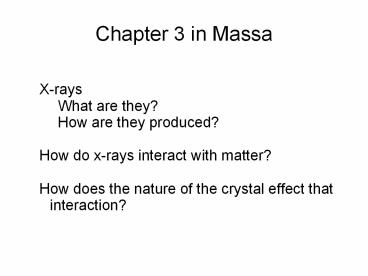Chapter 3 in Massa - PowerPoint PPT Presentation
Title:
Chapter 3 in Massa
Description:
Chapter 3 in Massa X-rays What are they? How are they produced? How do x-rays interact with matter? How does the nature of the crystal effect that interaction? – PowerPoint PPT presentation
Number of Views:83
Avg rating:3.0/5.0
Title: Chapter 3 in Massa
1
Chapter 3 in Massa
- X-rays
- What are they?
- How are they produced?
- How do x-rays interact with matter?
- How does the nature of the crystal effect that
interaction?
2
Homework Problem 3
3
Wilhelm Röntgen (1845-1923)?
4
Crook's Tubes
5
Crook's Tubes
6
Crooks Tubes
- Produced cathode rays
- Cathode rays were particles
- Cathode rays did not penetrate matterthey
were not observed outside the tube. - Cathode rays were charged.
7
The Discovery of X-rays in 1895
- Röntgen was working in a very dark lab with a
Crook's tube. - Across the room was a watch glass containing
Ba2Pt(CN)4 - Whenever the Crook's tube was on the watch glass
glowed. - These were a new mysterious ray
- Named x-rays
8
What could you do with X-rays?
9
What were x-rays?
- Were they waves or particles?
- What was their wavelength (energy)?
- How were they produced?
- What more could be done with them?
- A question that wasn't asked until much later is
how safe are they?
10
There are two types of x-rays
11
Discrete Lines
12
X-rays
13
Modern X-ray Tube
14
Problems
- Most of the electrons are simply conducted by the
target. This produces a huge amount of heat in a
small area. - For example, a power supply might provide 20ma at
50Kv or 1Kw of power. Of this 97 will become
heat. - Obviously it is important that there be a good
vacuum between the filament and the anode or
there will be arcing.
15
One Solution to the heat Problem
- We can better dissipate the heat if we spin the
target - This is a rotating anode generator
- In this case the vacuum must be kept by pumps
- Need a seal to hold 1x10-8mm vacuum and allow
anode to spin at 3000-6000 rpm.
16
Rotating Anodes
- Expensive to purchase
- Expensive to maintain
- 12 fold increase in beam intensity
- Various beam diameters are possible
- The main x-ray source at Purdue is a rotating
anode generator.
17
Need Even More Intensity
- Want 2 to 3 orders of magnitude or more.
- Want tunable wavelength
- Want very small beam size
- Use a synchrotron.
- Accelerate electrons to near the speed of light
and have them circle around a large circle - Only standing waves of the circle diameter will
be allowed
18
The Advanced Photon Source
19
(No Transcript)
20
Which Wavelength to Use
- Generally use Cu 1.5418Å or Mo 0.71073Å
- The longer the wavelength the farther apart the
diffraction spots are in space. For large unit
cells like macromolecules use Cu. - Cu produces more x-rays and the detectors have a
higher efficiency in measuring them. - Mo is not as absorbed as Cu. Best for heavy
element problems.
21
Homework































